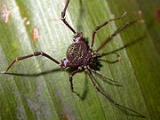
Lacronia
Encyclopedia
Lacronia Strand, 1942 is a genus of Pachylinae
(Arachnida, Opiliones
, Gonyleptidae
), which includes four Brazil
ian species
. A striking diagnostic character is the trochanter IV of male with strong medial prolateral apophysis
forming a pincer with the dorso-apical apophysis of coxa IV. Two of these species present neon green stripes on the mesotergum (Kury, 2003b), which is uncommon in this subfamily.
). Strand (1942) proposed the valid replacement name Lacronia, which was ignored by most subsequent authors and unearthed only 60 years later (Kury, 2003a).
to be found in highlands away from the coast. The other three species of Lacronia are known from coastal environments: Lacronia serripes is known only from small islands. The other two were found in continental "restinga
" biome. Individuals of both sexes of Lacronia ceci were found inside bamboo
(Guadua taguara) hollows or in immediately surrounding areas. No individuals were found in other locations during diurnal collectings. Lacronia camboriu and L. ricardoi were found inside bromeliads, suggesting that the species of this genus are related to phytotelmata
(Kury & Orrico, 2006).
Pachylinae
Pachylinae Sørensen, 1884 is the most diverse subfamily of the harvestman family Gonyleptidae, including around 400 valid species . Major groups of species occur in the Brazilian Atlantic Forest, Bolivian/Peruvian Highlands, Argentina and Chilean Temperate Forest.- Important genera :Currently, 128...
(Arachnida, Opiliones
Opiliones
Opiliones are an order of arachnids commonly known as harvestmen. , over 6,400 species of harvestmen have been discovered worldwide, although the real number of extant species may exceed 10,000. The order Opiliones can be divided into four suborders: Cyphophthalmi, Eupnoi, Dyspnoi and Laniatores...
, Gonyleptidae
Gonyleptidae
Gonyleptidae is a Neotropical family of harvestmen with more than 800 species, the largest in the Suborder Laniatores and the second largest of the Opiiones as a whole...
), which includes four Brazil
Brazil
Brazil , officially the Federative Republic of Brazil , is the largest country in South America. It is the world's fifth largest country, both by geographical area and by population with over 192 million people...
ian species
Species
In biology, a species is one of the basic units of biological classification and a taxonomic rank. A species is often defined as a group of organisms capable of interbreeding and producing fertile offspring. While in many cases this definition is adequate, more precise or differing measures are...
. A striking diagnostic character is the trochanter IV of male with strong medial prolateral apophysis
Apophysis
Apophysis is an open source fractal flame editor and renderer for Microsoft Windows.Apophysis has many features for creating and editing fractal flames, including an editor which allows one to directly edit the transforms by manipulating triangles, a mutations window, which applies random edits to...
forming a pincer with the dorso-apical apophysis of coxa IV. Two of these species present neon green stripes on the mesotergum (Kury, 2003b), which is uncommon in this subfamily.
Taxonomic history
This genus was at first called Luederwaldtia Mello-Leitão, 1923, but the name was already preoccupied, being a junior homonym of Luederwaldtia Schmidt, 1922 (HemipteraHemiptera
Hemiptera is an order of insects most often known as the true bugs , comprising around 50,000–80,000 species of cicadas, aphids, planthoppers, leafhoppers, shield bugs, and others...
). Strand (1942) proposed the valid replacement name Lacronia, which was ignored by most subsequent authors and unearthed only 60 years later (Kury, 2003a).
Species
- Lacronia camboriu Kury, 2003 - Santa CatarinaSanta Catarina (state)Santa Catarina is a state in southern Brazil with one of the highest standards of living in Latin America. Its capital is Florianópolis, which mostly lies on the Santa Catarina Island. Neighbouring states are Rio Grande do Sul to the south and Paraná to the north. It is bounded on the east by...
(coast) - Lacronia ceci Kury & Orrico, 2006 - Rio de JaneiroRio de JaneiroRio de Janeiro , commonly referred to simply as Rio, is the capital city of the State of Rio de Janeiro, the second largest city of Brazil, and the third largest metropolitan area and agglomeration in South America, boasting approximately 6.3 million people within the city proper, making it the 6th...
(mountains) - Lacronia ricardoi Kury, 2003 - São PauloSão PauloSão Paulo is the largest city in Brazil, the largest city in the southern hemisphere and South America, and the world's seventh largest city by population. The metropolis is anchor to the São Paulo metropolitan area, ranked as the second-most populous metropolitan area in the Americas and among...
(southern coast) - Lacronia serripes (Mello-Leitão, 1923) - São Paulo (islands in northern coast)
Ecological remarks
Lacronia ceci is the first species of the genusGenus
In biology, a genus is a low-level taxonomic rank used in the biological classification of living and fossil organisms, which is an example of definition by genus and differentia...
to be found in highlands away from the coast. The other three species of Lacronia are known from coastal environments: Lacronia serripes is known only from small islands. The other two were found in continental "restinga
Restinga
Restinga is a municipality in the state of São Paulo in Brazil. The population in 2004 was 6,188 and the area is 246.37 km². The elevation is 910 m....
" biome. Individuals of both sexes of Lacronia ceci were found inside bamboo
Bamboo
Bamboo is a group of perennial evergreens in the true grass family Poaceae, subfamily Bambusoideae, tribe Bambuseae. Giant bamboos are the largest members of the grass family....
(Guadua taguara) hollows or in immediately surrounding areas. No individuals were found in other locations during diurnal collectings. Lacronia camboriu and L. ricardoi were found inside bromeliads, suggesting that the species of this genus are related to phytotelmata
Phytotelmata
Phytotelma is a term for water bodies held by plants. The water accumulated on these plants may serve as substratum for associated fauna, and often the fauna associated with phytotelmata is unique....
(Kury & Orrico, 2006).

